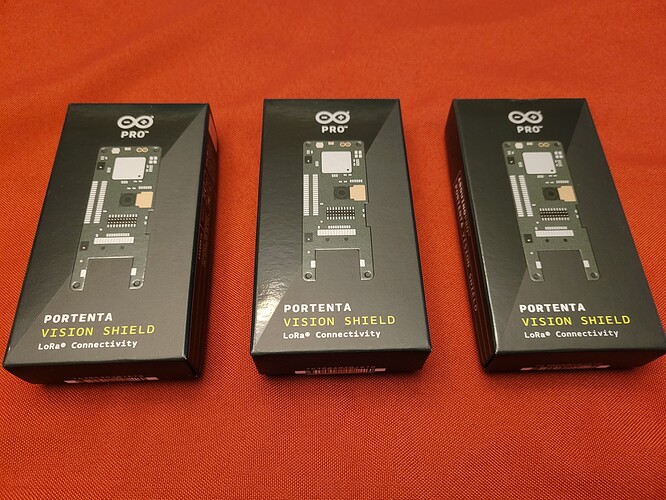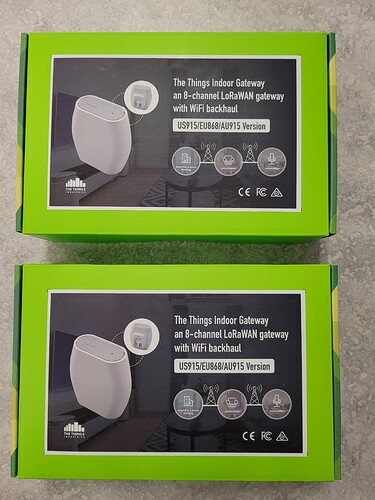Thanks for the feedback @Robotastic, can’t wait to read your tutorial!
Anyone know if a board with WiFi, crypto and LoRa like the PortentaH7 with the Lora Vision Shield could be programmed as a Gateway? Guess I should ask Arduino since I think they have their own gateway.
Quick google
Mouser selling it link works for me here.
This one is RPI 3+ powered so code will be very different. Back to the original question, could a board be a gateway or are the speeds just too slow?
Proper gateways can listen on 8 or 16 channels, a transceiver on an end-device has only a single channel. So the only thing you can implement is a single-channel gateway, which is highly frowned upon by the community, as they have detrimental effect on the rest of the network. See https://www.thethingsnetwork.org/forum/t/the-future-of-single-channel-gateways/6590
Thanks @janjongboom still fairly new to LoRA and also haven’t received any of my LoRa capable boards yet, so no personal knowledge.
I have an RPI3+ so could probably build my own multichannel Gateway, but will have to wait for better tutorials and after I have tested my own point-to-point ideas.
Yeah I’ve turned a Rpi3 into a gateway with https://shop.imst.de/wireless-modules/lora-products/8/ic880a-spi-lorawan-concentrator-868-mhz?c=12&gclid=Cj0KCQiA7NKBBhDBARIsAHbXCB4J6kWGU_dv00wTPrIalWyS420OXdZ_Y_Qk_knbVtZMYOuH1OTmas0aAsarEALw_wcB but these days I’d just get a The Things Indoor gateway.
@arijit_das_student and @BigCatBrother I just tried Sandeepmistry/Arduino-LoRa both loraReceiver and loraSender compile but did not get past
if (!LoRa.begin(915E6)) { }
Arduino is looking into it today. Any other suggestions to try for Arduino programming?
I am a bit confused by the MKRWAN examples. (DumbModemLoraSender, FWUpdaterBridge, FirstConfiguration, LoraSendAndReceive, MKRWANFWUpdate_standalone
) I think all of these are expecting the things Network. Any other suggestions for point-to-point LoRa?
@arijit_das_student you mentioned using LoRa combined with RTOS systems to implement LoRaMesh schemes. I know nothing about RTOS, any links about what you have working.
I will also try OpenMV but fairly sure it will need TheThingsNetwork which I am 40 km in either direction away from the nearest gateway.
My Single channel gateway is in the mail.
…
I ordered a single channel Gateway, but my school happened to order 2 multichannel gateways that just showed up 
P.S. I am still interested in point-to-point LoRA using the LoRaVisionShields but at least now I can get started testing normal LoRaWan.
So to do point-to-point LoRa:
- On the receiving end, set a frequency (not the frequency plan, but the actual frequency, I guess there’s something for that in Sandeep’s library), set a data rate, and open a receive window.
- On the sending end, set the same frequency, set the same data rate, send a message.
Can someone explain what is happening with the Things network v2 and the things stack v3. It looks like the free things network is being taken over by a pay to use things stack. Anyone got information here?
The Things Stack (v3) is still open source. It’s just the new iteration of the network stack of The Things Network (commercial version is available, but I think it’s the same product). They’re now moving over the public TTN console over to v3 (public TTN is still at v2).
I will have to take break from the Arduino PortentaH7 LoRa Vision Shield. I can’t seem to get any of it working. I even went for a 100 km drive around known Gateways with three shields flashing connection attempts every 3 seconds. Seems others in North America are having similar issues with MKRWAN 1300, which the Portenta is based off.
I may try either MBED or RTOS methods and may also try making my own V3 online stack, but probably best to shelve it until someone else proves it works using the US915 or US915_HYBRID bands.
My site for this is at https://github.com/hpssjellis/my-examples-for-the-arduino-portentaH7/tree/master/research/LoRaWan
Because Arduino is sticking with LoRaWan without LoRa I can’t even take 2 shields and test their connectivity.
This was a lot of work, time, and money for not getting any results. 
I am very interested!
I plan to use TinyML with LoRa in agriculture. Especially the direct connection between two or more nodes (node to node via LoRaMAC / LoRaMesh)
Direct connection seems to be a function in most LoRaWan chips. The Arduino LoRa Vision shield did not connect those pins, so presently only LoRaWan can be done on the vision board. Also it works in Europe but I am having issues in North America, also The ThingsNetwork is in the middle of a big switch from V2 to V3, with possibly a cost for use.
If anyone has tried LoRaWan on the Helium HNT network I would be interested in trying to connect the Vision Shields. Helium seems to be a big deal in North America
Update here (March 6th, 2021):
After 2 x 100 km drives to find stable Gateways, I have had no luck getting the PortentaH7 Vision Shield (LoRaWan version) working on TTN either V2 theThingsNetwork.com or V3 thethingsindustries.com.
I did however get packets sending and receiving on the helium.com “People Powered HTN Crypto Network” that is big in the States and is getting bigger in Europe. https://explorer.helium.com/coverage
If I fully get it working I will make a video on my Edge Impulse Playlist, but so far the default MKRWAN setup worked for me fairly easily. Helium gives 10,000 data credits to start which relates to bytes. My testing used up 13 credits.
Not really what I wanted, but at least it worked (so far) and it looks like TTN is going towards a pay-to-use model anyway.
Would be very interested if this thread could be turned into a ‘community project’. I’m very new to the TinyML / LoRa ecosystem - playing with some commercial implementations - and would love to get some hands-on (aka hand holding) experience to demonstrate a simple environmental project. Whether that be the ‘sheep tracking’ or ‘bird calls’ TinyML project, for me it’s about learning more about the deployment architecture. Is this in scope for Edge Impulse to set up and moderate? The idea being that we as a community would all go out and get the same board, shield etc. and together would configure the board and run through a tutorial to get a project up and running.
@GlennML Interesting idea, defering to @aurel and @jenny who manage the community.
Just reposting some things that we’ve done:
- https://github.com/edgeimpulse/example-portenta-lorawan - Vision+LoRaWAN on Portenta H7
- https://www.edgeimpulse.com/blog/bird-classification-lacuna-space - bird classification w/ LoRaWAN (and space backhaul via Lacuna) on Arduino Nano 33 BLE Sense.
@janjongboom Thanks for the quick follow up. I’ve gone through these examples and would love to actually be able to demonstrate with my own sandbox. I don’t have the background in embedded tech to fight through some of the issues that @Rocksetta has already run into. To be honest, I get mixed messages about what boards and shields will actually work together. Would love to have one ‘blessed’ configuration that I can work on with others to implement your examples. If that’s the portenta-lorawan project, great! Once we have the sandbox environment, then we can start pushing the value of TinyML & Edge Impulse. IMHO.
Short term: Portenta + LoRa Vision shield indeed as the blessed combination, or the ST IoT Discovery Kit + SX1276 shield with some custom work (https://www.edgeimpulse.com/blog/adding-machine-learning-to-your-lorawan-device).
That community project is an interesting idea! I would definitely work with @Rocksetta on ways we could go about doing this. We could always setup a community GitHub repository that everyone could contribute to - what are your thoughts?


